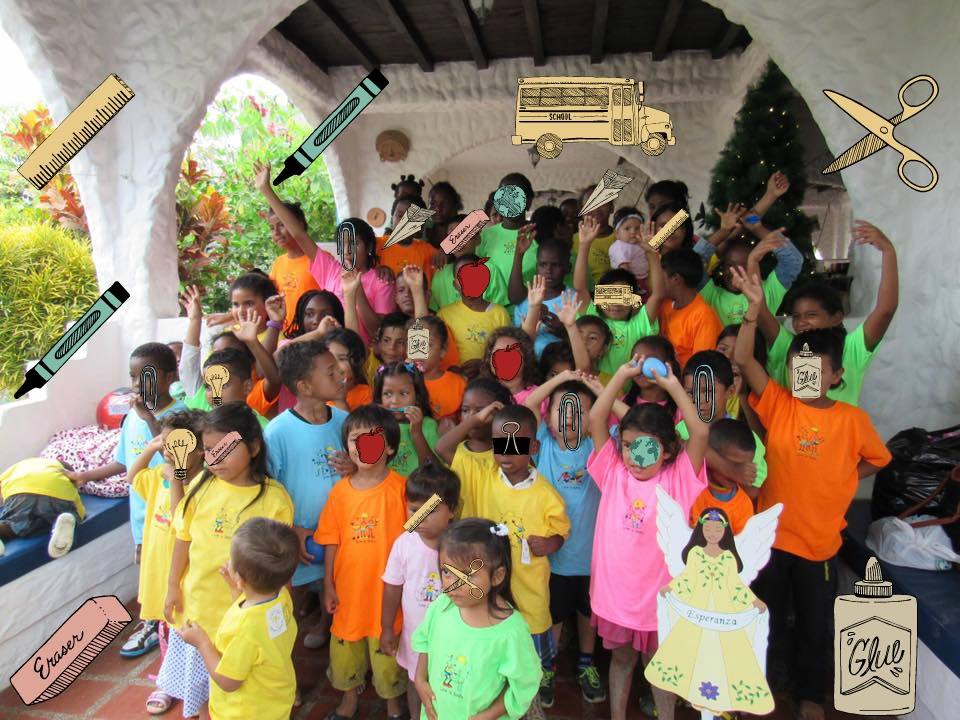I believe that nothing in life is truly FREE and education in Ecuador is one of those things.
My focus is on the hardships and realities posed to the families with school-aged children each year at this time. I would like to address some common misconceptions about the process as well. My only point of reference is coastal conditions and it is my understanding that the mountain schools have a different start date.
The quality of education and services varies greatly from facility to facility so I am not comfortable making generalized statements as to what I feel may be lacking. Each educational experience can differ depending on location, whether it is public or private, the quality of the neighborhood it is located in, the number and quality of teachers and also the ability and intention of the Director (Principal) of any given school; each variable can positively or negatively impact a child’s overall learning experience.
The country offers numerous private educational facilities that the wealthier families can choose from. English and computer classes along with better overall attention and service can be expected in private facilities.
The majority of the population, however, relies on the free public school system.
As in other institutions, the education system is not immune to corruption concerns in how the allotted federal resources may be utilized. As a foreigner, I do not feel it is my position to comment too deeply on their system. How, if and when the funds and materials may be distributed are best left for another conversation. My opinion means relatively little to the big machine. I choose to focus on solutions to help families with their immediate needs so the children have the best chance of receiving an education.
It is the law that children attend school.
It is mandatory to send your child to school, however, the truth is many children simply do not finish their studies due to the annual initial cost of items required. The families I speak about tend to live on the outskirts of your vision, just off the beaten path. They make up a large percentage of the population of Ecuador and they are grateful if they can actually earn the minimum wage of approximately $360 monthly.
I had the great pleasure of getting to know a local family that had one child, Abigail. It would have been her first year of school in April/May of 2014. I asked her family member if Abigail was getting excited about going to school. The tone of the conversation changed, the head hung low and the response was; she won’t be going this year.
I was puzzled, surely she was going, why on earth would she not go? Furrowed brow; I simply had to ask why?
What I was told is that the parents did not have the money for the list. Still puzzled, I asked what list? How much is this list? The response was; “About $100”.
My Spanish skills were very caveman-like back in 2014. After I processed the information for a couple of minutes; I repeated key phrases to ensure I understood what I was hearing;
So this young girl was going to miss her first year of school because the family lacked $100 to buy stuff on a list. The immediate thought that flashed in my head was; -Nonsense, that simply can’t happen-
Saving you all the little details, calls and conversations that took place, I will skip directly to summarize that 6 children from 4 families received sponsors to help purchase the items for the 2014 year, including Abigail. Give or take we were able to collectively purchase a significant amount of items for $100 per child but it did not cover each and every item. It sure did help make a dent, though!.
An annual tradition begins
The 2015 school year had 46 children with sponsors and 2016 had 52 children that received assistance. There were other people that started initiatives in their local areas and also individuals that reached out to workers and families near to them to offer assistance. The ripple effect was amazing to see.
This year is still a work in progress. On the coast, they return to school starting April 24 for high school students and more grade levels return daily through that week until the Kindergarten children finally return on May 1.At present we have 46 children sponsored; The families we work with are planning food sales to help supplement the costs so as a group more children will receive even partial assistance.
The girl who brought awareness
I will forever think of Abigail, as the spark that benefited many children and families over subsequent years go to school.

The Lists:
The lists vary in content and price depending on the grade and school you attend. The lists can be printed from the Ministry of Education site or gotten through the teachers at the very start of the school year. Often the teachers modify the lists, excluding items and adding in others. High school students also receive supplementary lists depending on specific courses they may take.
Some items that are similar across the grades include notebooks, pens, pencils, colored pencils, erasers, rulers, sharpener, printer paper, scissors. The younger grades concentrate more on spelling booklets, glue, foamy type construction papers, colored sprinkles, and Plasticine, while the older grades include calculators, protractor/compass sets, and geometric rulers.
Materiales de Aseo (hygiene items) that may include any combination of toilet paper, hand soap, toothbrush and paste, hand towels, paper towels, combs or brushes to name a few are also on the list. The list pictured here from last year shows 3 rolls of toilet paper listed among many other things.

The Costs:
The costs vary considerably depending on school and grade. Last year they averaged $43 for the group we purchased for; the highest being $67 and the lowest $28. These, of course, were the costs only for the stationary portion of the school lists and did not include a backpack to carry the items to and from school. The price also does not include the Materiales de Aseo. which was outlined earlier. These can cost an additional $10 per child depending on the hygiene items listed. This was also apart from uniforms.

They require both uniform and gym clothing. The uniforms consist of the nice white crisp shirts, colored pants or skirts (each school has a color they require) socks and at times ties and/or crests. The formal uniform also requires black dress shoes. All these prices vary depending on size and also if they need a crest or not. At times we have to pay a seamstress to make the skirts for high school students.

The gym clothes vary from crested shirts and blue sweat pants to gray matching sweatsuits. Both styles require the canvas sneakers; white for the girls and black for the boys.

There are some misinformation, misconceptions that I would like to take some time to address. I have spoken to parents, teachers, and students multiple times since 2014 to reach an understanding of what they face. I try to learn from them directly as this minimizes the chances for misunderstandings.
Some food for thought:
1. Workers receive a Decima in April equivalent to one month’s wages to help with the school supplies. For contract workers, the employer must pay them an equivalent to a months salary. In theory, this is true, there is a law that states this. The reality is that many workers do not actually fall under this law as they are not employed under contract.
On the coast, the people with the corner food carts, the beach chair renters, the taxi drivers with their own vehicles, the vegetable stand owners, the meat-on-a-stick vendor, the booth worker at the souvenir stands, the man driving around with a load of pineapples in the back of his truck. The lady that cleans your apartment one day per week, that you and your friends share services with is likely not under contract.
Often the Mom & Pop restaurants have their family working and as a family run business, they tend to keep it that way. Again no extra months wage is passed to the workers. None of these listed workers are eligible for a Decima as they are self-employed. This list is not comprehensive and only addresses a few of the types of workers that do not fall under this law.
2. The government Education website states all children receive a uniform. Yes, it does say that but the reality is they do not receive anything. I spoke to numerous parents in various schools on the peninsula and they disagreed fully with the web statement. They let me know they have never received free uniforms. What the website refers to is the gray suits for gym class but in reality, not everyone receives them either. Each school seems to distribute them in their own manner or not at all. One school gives them, but only to very first-year students. Another school will give it out to everyone, but mid-year, meaning parents still need to supply for the start of the year. A few parents actually sent questions through the website asking about this statement and never received a response that I am aware of.
a few more misconceptions…
3. Anything is better than nothing: The lists are very specific on what is required by each student. Each grade has specifics, even down to the color of the notebooks and markers. There are many reasons for this and I do not believe it is for us to debate or change. One parent, I spoke with related that it takes the focus off the differences. Everyone is dressed the same and shows up to class all with a red notebook for math (hypothetical). There are no social or financial class differences when appearances are all the same. If some students show up with neon-flashing binders and the rest don’t, the focus is taken away from the studies. The child then becomes the focus. The difference between the haves and have nots bring up a feeling of envy and want.
Also, there is the rationale of order and unity. The military or police all dress the same, carry the same type of weapons, and do the same type of paperwork. There is a formality in their processes that must be respected regardless of our personal feelings towards it.
****
4. To imply that the families can purchase what they need to go to school for $20 or $30 does a disservice to the families. To suggest that we, as North Americans can come here, step in and fix their hardship with $20 bucks, in my opinion, minimizes their struggles. Anyone who has lived here long enough understands the high costs for luxury or paper items. What North Americans can routinely pick up at the dollar store, costs significantly more here.
When I asked the parents about the possibility of buying what they need for $30, their expressions were priceless. A good laugh, shock, confusion or a dismissive negative head shake. They wished they received free uniforms. They wished they could buy all they need for $30 per child but the realities are far different.
A high school list includes a USB memory stick, a calculator, and a protractor set. This is in addition to the routine stationary items. One can reasonably assess the true costs these families face. Particularly since single-child families are the exception, not the norm.
Contributions of $10, $20 or $30 collective go a long way to help reduce the burdens on these families but unfortunately does not cover the entire expense.
****
5. They cannot attend school without the items. This is not a true statement; it is mandatory to attend school in Ecuador. The question is then; What happens when you cannot afford to buy the necessary items?
I asked a mother, a student, and a teacher for their insight into this question. None of these people know each other and all live in different areas of the peninsula.
The mother’s response:
She let me know that it causes much embarrassment for the family. The family members, neighbors, and church members will help each other as they can. Passing down uniforms or extra stationary items as they are able. The teachers will continue to ask for the missing items as parents try to bring them in bit by bit. At times, they will stop going to the school as they do not want the confrontation. They may choose to keep the children out of school until such a time that they can bring the items. So, although the child is technically enrolled in school, they may miss days as they try to avoid the confrontation.
The teacher’s response:
Her response was direct and simple. If they don’t bring all the necessary (items) they just watch while the others work.
The student response:
He did not finish school because his family was very poor and he never had the items needed. He had to sit out and was not able to participate in lessons many times. Feeling embarrassed; that many times for gym class, he did not have the proper shoes so he was not allowed to participate. This caused him shame and finally, he stopped going.
Additional Information:
March 2015 I read in (la nota original. www.eltelegrafo.com.ec)
The governmental provision orders that in no case will the total expenditure between school materials, texts and uniforms may be greater than a minimum wage ($ 354).
This article discussed the full needs of students for school. This one lady will pay nearly $300 for one child.
What can you do to help;
I think just being aware sometimes can be helpful. Just understanding someone’s pain, fear, and struggles; approaching with a smile and a hug can say to them that you understand this is not easy for them.
Maybe choose to tip a little extra this time of the year for those you know have school-aged children. Let them know it is to help with their Utilies Escolares
Speak to the guardian of your building, the lady you buy your vegetables from; the person(s) you see each day and ask them how many kids they have. If you have the means, ask them if you can help purchase some of the items on their child’s school list. They will be impressed that you even know about these lists. If you are not comfortable handing them money, then ask for the list and go buy the items.
****
I would suggest helping those close to your geographic area for the best impact. So those of you in Cuenca and beyond, reach out to your locals and see what can be done. Work with them in coming up with ideas to earn income as a group. Find sponsors to help, get creative but remember to work with them, not above them.
If you would like to reach out to our group of children and families here on the coast, we would happily accept donations via PayPal to donate@ecuadorfromtheheart.com
At the moment, we have 46 children sponsored with another 15 children that could really use some help.
For more information email me at community@ecuadorfromtheheart.com
I wanted to close with a little thank you note from one of the children; it still brings a smile to my face.

PS… for April 2019 school year, just over 100 children will receive help in our area. This does not include the notes I received from people saying they helped their worker or guardian in their building this year.










